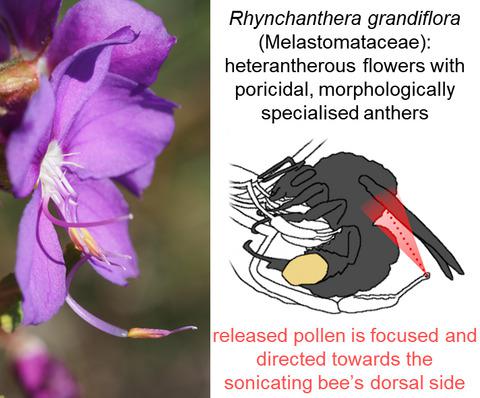当前位置:
X-MOL 学术
›
Plant Biol.
›
论文详情
Our official English website, www.x-mol.net, welcomes your feedback! (Note: you will need to create a separate account there.)
Morphological specialization of heterantherous Rhynchanthera grandiflora (Melastomataceae) accommodates pollinator diversity.
Plant Biology ( IF 3.9 ) Pub Date : 2020-02-28 , DOI: 10.1111/plb.13102 S Konzmann 1 , F Hilgendorf 1 , C Niester 1 , A R Rech 2 , K Lunau 1
中文翻译:

杂花大花Rhynchanthera grandiflora(Melastomataceae)的形态学专长适应传粉者的多样性。
更新日期:2020-02-28
Plant Biology ( IF 3.9 ) Pub Date : 2020-02-28 , DOI: 10.1111/plb.13102 S Konzmann 1 , F Hilgendorf 1 , C Niester 1 , A R Rech 2 , K Lunau 1
Affiliation

|
- The tropical Melastomataceae are characterized by poricidal anthers which constitute a floral filter selecting for buzz‐pollinating bees. Stamens are often dimorphic, sometimes with discernible feeding and pollinating functions. Rhynchanthera grandiflora produces nectarless flowers with four short stamens and one long stamen; all anthers feature a narrow elongation with an upwards facing pore.
- We tested pollen transfer by diverse foraging bees and viability of pollen from both stamen types. The impact of anther morphology on pollen release direction and scattering angle was studied to determine the plant's reproductive strategy.
- Medium‐sized to large bees sonicated flowers in a specific position, and the probability of pollen transfer correlated with bee size even among these legitimate visitors. Small bees acted as pollen thieves or robbers. Anther rostrum and pore morphology serve to direct and focus the pollen jet released by floral sonication towards the pollinator's body. Resulting from the ventral and dorsal positioning of the short and long stamens, respectively, the pollinator's body was widely covered with pollen. This improves the plant's chances of outcrossing, irrespective of which bee body part contacts the stigma. Consequently, R. grandiflora is also able to employ bee species of various sizes as pollen vectors.
- The strategy of spreading pollen all over the pollinator's body is rather cost‐intensive but counterbalanced by ensuring that most of the released pollen is in fact transferred to the bee. Thus, flowers of R. grandiflora illustrate how specialized morphology may serve to improve pollination by a functional group of pollinators.
中文翻译:

杂花大花Rhynchanthera grandiflora(Melastomataceae)的形态学专长适应传粉者的多样性。
- 热带梅花科的特征是有孔的花药,它构成了一种花蜜过滤器,可以选择蜜蜂授粉的蜜蜂。雄蕊通常是二态的,有时具有可辨别的摄食和授粉功能。大花Rhynchanthera grandiflora产生无花蜜,有四个短雄蕊和一个长雄蕊。所有的花药都具有狭窄的伸长率和朝上的孔。
- 我们通过各种觅食蜂和两种雄蕊类型的花粉生存力测试了花粉转移。研究了花药形态对花粉释放方向和散射角的影响,以确定植物的繁殖策略。
- 中型到大型蜜蜂在特定位置对花朵进行超声波处理,即使在这些合法访客中,花粉转移的概率也与蜜蜂的大小相关。小蜜蜂充当花粉小偷或强盗。花药的讲台和孔的形态有助于将花的声处理释放的花粉射流引导并集中在授粉者的身上。由于短雄蕊和长雄蕊的腹侧和背侧位置,授粉者的身体被花粉广泛覆盖。无论哪个蜜蜂的身体部位接触柱头,这都增加了植物杂交的机会。因此,大花红景天还能够采用各种大小的蜜蜂作为花粉载体。
- 将花粉散布到传粉者体内的策略成本很高,但通过确保实际上释放的大部分花粉已转移到蜜蜂上来抵消。因此,大花R. grandiflora的花朵说明了专门的形态可能如何通过授粉媒介的功能群来改善授粉。



























 京公网安备 11010802027423号
京公网安备 11010802027423号